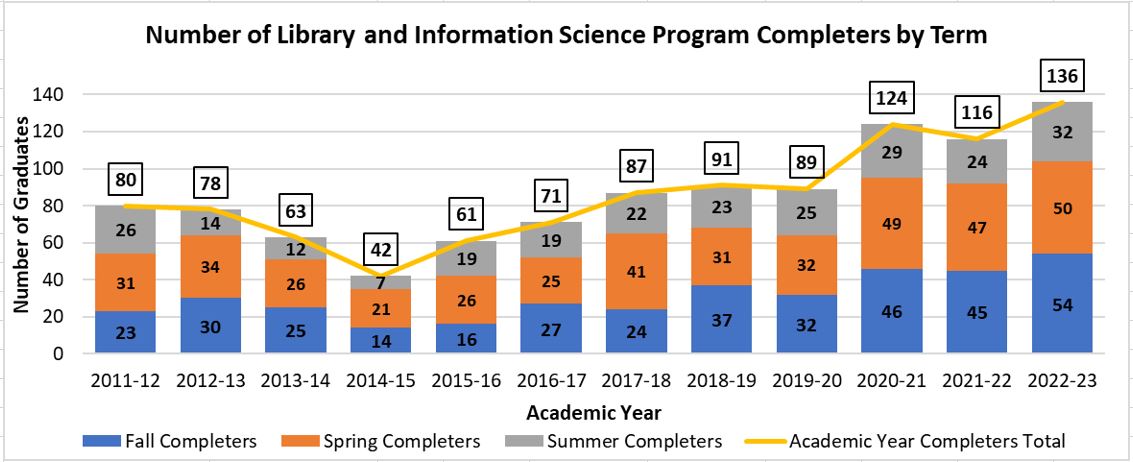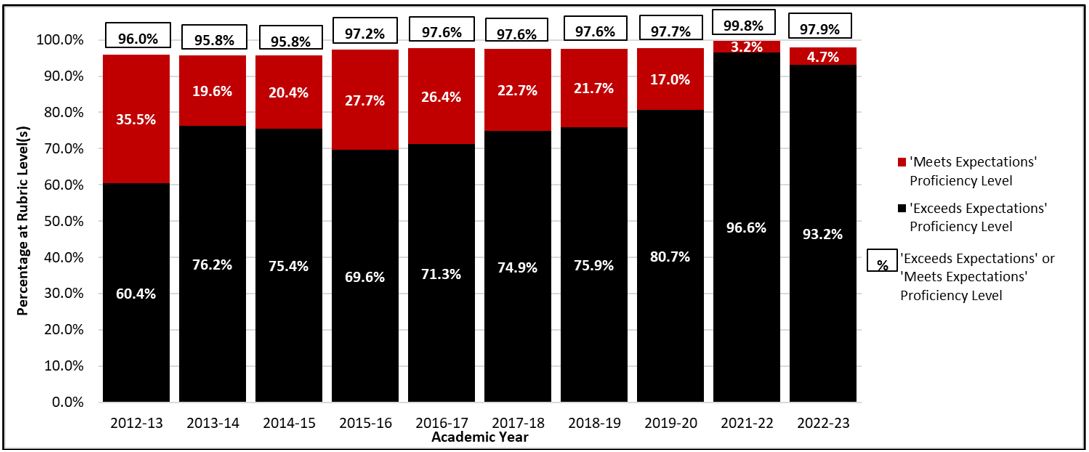Program Outcomes
Page Contents
- Key Statistics
- Student Acceptance, Retention, and Graduation Rates
- Student Learning Outcome Assessment (SLOA) Results
- Employment Outcomes and Stakeholder Surveys
Key Statistics
Retention rate: Percentage of enrolled students who enrolled a term one year or longer after their first semester of program admission/readmission.
| Cohort Academic Year | # of Accepted Applicants Who Enrolled | Retention Rate1 |
| 2022-23 | 151 | 90.1 |
| 2021-22 | 144 | 85.4 |
| 2020-21 | 160 | 86.3 |
| 2019-20 | 170 | 92.4 |
| 2018-19 | 146 | 90.4 |
| 2017-18 | 115 | 87.8 |
| 2016-17 | 102 | 89.2 |
| 2015-16 | 101 | 95.0 |
| 2014-15 | 105 | 80.0 |
| 2013-14 | 81 | 88.9 |
| 2012-13 | 66 | 84.8 |
| 2011-12 | 71 | 87.3 |
| Data as of February 2024. Note: Cohort Academic Year is based on the semester in which the applicant applied to begin or continue in his/her program. These numbers include applicants seeking readmission into the MLIS program. Cohort Academic Year runs from fall - summer term (ex. 2018-19 is Fall 2018, Spring 2019, and Summer 2019 data combined). 1 Students who complete their program in less than three semesters are identified as retained in the table. |
||
Average time to degree completion
| Cohort Academic Year | Number of Graduates | Time to Completion (in years) | |||
| Mean | Median | Mode | Standard Deviation | ||
| 2021-22 | 37 | 2.11 | 2.0 | 2.0 | 0.75 |
| 2020-21 | 101 | 2.41 | 2.3 | 2.3 | 0.51 |
| 2019-20 | 132 | 2.67 | 2.7 | 2.3 | 0.68 |
| 2018-19 | 122 | 2.73 | 2.7 | 2.3 | 0.85 |
| 2017-18 | 92 | 2.74 | 2.7 | 2.3 | 0.85 |
| 2016-17 | 84 | 2.85 | 2.3 | 2.3 | 1.05 |
| 2015-16 | 89 | 2.98 | 2.7 | 2.3 | 1.03 |
| 2014-15 | 76 | 2.90 | 2.7 | 2.3 | 1.00 |
| 2013-14 | 66 | 3.28 | 3 | 2.3 | 1.23 |
| 2012-13 | 52 | 2.88 | 2.7 | 2.7 | 0.89 |
| 2011-12 | 58 | 2.65 | 2.7 | 2.3 | 0.77 |
Note: Data as of February 2024. Note: Cohort Academic Year is based on the semester in which the applicant applied to begin the MLIS program. Applicants who sought readmission into the MLIS program are only reported for their first Cohort Academic Year. Time to Completion includes semesters when the graduate did not enroll in any MLIS courses; however, when a student is readmitted, his/her inactive semesters are removed from the calculation.
Student Acceptance, Retention, and Graduation Rates
The Master of Library and Information Science (MLIS) program has competitive admissions due to the program's high volume of quality applicants. The program accepts new applicants twice per year (fall and spring semesters) and students are contacted by the VSU Graduate School when an application decision has been made. Students are assigned a high-quality academic advisor upon admission and typically take approximately 2 1/2 - 3 years to complete the MLIS degree program.
| Cohort Academic Year | Total # of Applications1 | # of Applicants Accepted | # of Applicants Denied | % Accepted |
| 2023-24 | 326 | 208 | 118 | 63.8 |
| 2022-23 | 236 | 161 | 75 | 68.2 |
| 2021-22 | 242 | 166 | 76 | 68.6 |
| 2020-21 | 277 | 167 | 110 | 60.3 |
| 2019-20 | 339 | 198 | 141 | 58.4 |
| 2018-19 | 294 | 152 | 142 | 51.7 |
| 2017-18 | 249 | 115 | 134 | 46.2 |
| 2016-17 | 248 | 102 | 146 | 41.1 |
| 2015-16 | 213 | 105 | 108 | 49.3 |
| 2014-15 | 155 | 107 | 48 | 69.0 |
| 2013-14 | 143 | 83 | 60 | 58.0 |
| 2012-13 | 104 | 67 | 37 | 64.4 |
| 2011-12 | 104 | 72 | 32 | 69.2 |
| Note: Cohort Academic Year is based on the semester in which the applicant applied to begin or continue in his/her program. These numbers include applicants seeking readmission into the MLIS program. 1 Withdrawn or incomplete applications are not considered in the applicant pool. |
||||
| Cohort Academic Year | # of Accepted Applicants Who Enrolled | % of Accepted Applicants Who Enrolled | % of Enrolled Students Who Were Retained in Program One Year Later2 | % of Enrolled Students Who Graduated with MLIS Degree3 | % of Enrolled Students Who Have Not Graduated Yet But Are Considered Active Students4 |
| 2023-24 | 174 | 83.7 | N/A | 0.0 | 100.0 |
| 2022-23 | 151 | 93.8 | 90.1 | 1.3 | 91.4 |
| 2021-22 | 144 | 86.7 | 85.4 | 25.7 | 56.3 |
| 2020-21 | 160 | 95.8 | 86.3 | 63.1 | 15.0 |
| 2019-20 | 170 | 85.9 | 92.4 | 77.6 | 7.1 |
| 2018-19 | 146 | 96.1 | 90.4 | 83.6 | 3.4 |
| 2017-18 | 115 | 100.0 | 87.8 | 80.0 | 0.9 |
| 2016-17 | 102 | 100.0 | 89.2 | 82.4 | 1.0 |
| 2015-16 | 101 | 96.2 | 95.0 | 88.1 | 1.0 |
| 2014-15 | 105 | 98.1 | 80.0 | 72.4 | 0.0 |
| 2013-14 | 81 | 97.6 | 88.9 | 81.5 | 0.0 |
| 2012-13 | 66 | 98.5 | 84.8 | 78.8 | 0.0 |
| 2011-12 | 71 | 98.6 | 87.3 | 81.7 | 0.0 |
| Data as of February 2024. Note: Cohort Academic Year is based on the semester in which the applicant applied to begin or continue in his/her program. These numbers include applicants seeking readmission into the MLIS program. Each semester, new graduates can originate from any of these cohort academic years. 2 Students who complete their program in less than three semesters are identified as retained in the table. 3 It typically takes part-time students about 2 ½ to 3 years to complete the MLIS degree program. 4 An active student is considered a student who has enrolled in MLIS coursework within the last three semesters. |
|||||

Student Learning Outcome Assessment (SLOA) Results
Students enrolled in the MLIS program are assessed throughout their program to ensure they are meeting programs expectations. The assessments are based on American Library Association standards and the program's student learning outcomes. Assessment data are collected within an electronic assessment management system and are reviewed annually by the MLIS Assessment Committee.
Student Learning Outcome Assessment Performance Academic Year 2012-2023

Employment Outcomes and Stakeholder Surveys
The MLIS program systematically contacts three types of stakeholders in order to gain valuable feedback on the program and its intended outcomes. MLIS students are asked to evaluate their preparation to enter the professional workforce during their final semester of the program. The same evaluation categories, which are based on ALA standards, are used on the MLIS alumni and employer survey. Alumni are contacted every two years and employers are contacted every three years to solicit feedback on program effectiveness. The results from these surveys are analyzed by the MLIS Assessment Committee on an annual basis and reported out to program faculty.
Alumni Employment Status 12-24 Months After Graduation
| Program Graduates and Response Rate | Calendar Year of Graduation | Academic Year (Sum. - Spr.) | ||||||
| 2013 | 2014 | 2015 | 2016 | 2017 | 2018 | 2019 |
2020-21 |
|
| Number of Graduates | 65 | 47 | 49 | 71 | 68 | 100 | 86 | 120 |
| Number of Survey Respondents | 35 | 32 | 28 | 31 | 33 | 36 | 28 | 12 |
| Survey Response Rate | 53.8 | 68.1 | 57.1 | 43.7 | 48.5 | 36.0 | 32.6 | 10.0 |
| Percentage of Alumni Survey Respondents Employed in the Library & Information Field | 94.3 | 90.6 | 78.6 | 96.8 | 93.9 | 94.4 | 100.0 | 83.3 |
| Percentage of Alumni Survey Respondents Employed in an Academic or Public Library | 85.7 | 75.0 | 64.3 | 84.4 | 82.4 | 77.8 | 96.4 | 75.0 |
MLIS Program Stakeholder Survey Results
Dept. of Library and Information Studies
-
Odum Library
1500 N. Patterson St. Valdosta, Georgia 31698 -
Mailing Address
1500 N. Patterson St.
Valdosta, GA 31698 - Phone: 229.333.5966
- Fax: 229.259.5055